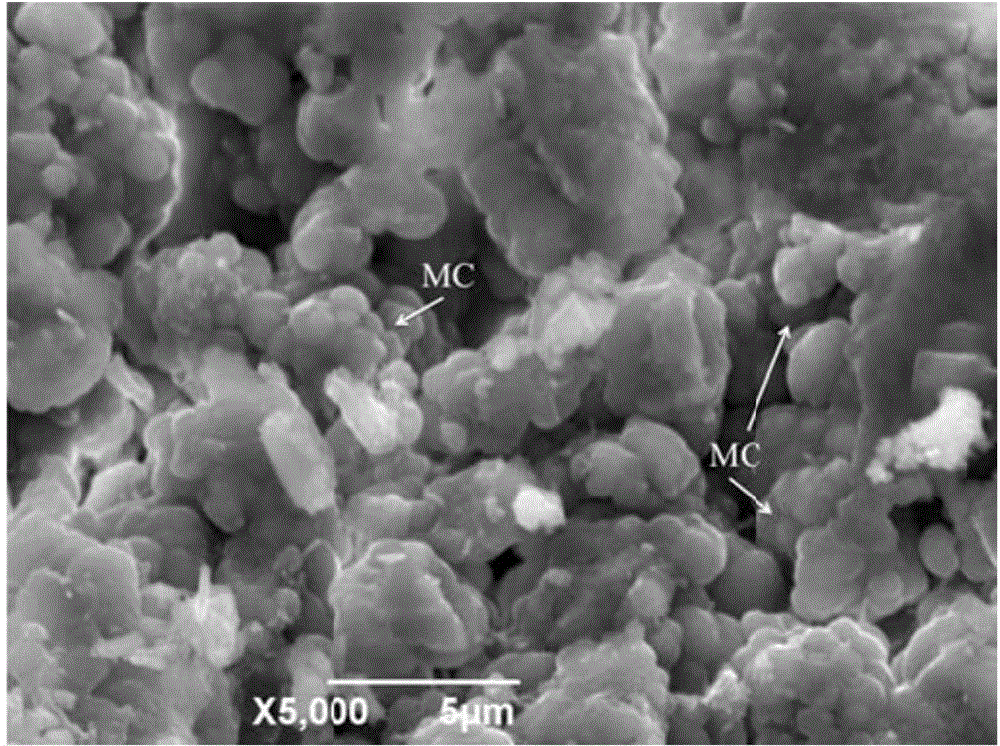Calcium-magnesium carbonate gel material and preparation method thereof
A cementitious material, carbonate technology, applied in the field of building materials, to achieve the effect of promoting energy saving and emission reduction, excellent flexural strength and compressive strength, and low cost
- Summary
- Abstract
- Description
- Claims
- Application Information
AI Technical Summary
Problems solved by technology
Method used
Image
Examples
Embodiment 1
[0028] Fly ash, activated magnesia and cement are selected as the main raw materials. In terms of mass percentage, fly ash accounts for 50%, active magnesium oxide accounts for 20%, and cement accounts for 30%. The activity index of activated magnesium oxide is 50s, and the specific surface area is 55m 2 / g. The cement is Portland cement with a specific surface area of 420m 2 / kg. The fly ash was taken from a thermal power plant in Nanjing, and the CaO content was 4.8% (mass ratio). Mix the above three raw materials evenly, add water, stir to make a uniform slurry, and cast a 40×40×40mm test piece. Using CO 2 Conservation, CO 2 The concentration is 99.9%, the pressure is 1.5MPa, the carbonization temperature is 40°C, and the reaction takes 3 hours. After the carbonization reaction, the weight increase (that is, the absorption of carbon dioxide) is about 11%, the flexural strength of the specimen is 4.9MPa, and the compressive strength is 45MPa.
Embodiment 2
[0030] Select ground slag, active magnesium oxide (same as embodiment 1) and cement (same as embodiment 1) for use as main raw materials. The specific surface area of ground slag is 450m 2 / kg, the CaO content is 36%, and the MgO content is 12% (mass ratio). In terms of mass percentage, slag accounts for 60%, active magnesium oxide accounts for 20%, and cement accounts for 20%. Mix the above three raw materials evenly, add water, stir to make a uniform slurry, and cast a 40×40×40mm test piece. Using CO 2 Conservation, CO 2 The concentration is 99.9%, the pressure is 1.0MPa, the carbonization temperature is 40°C, and the reaction takes 6 hours.
[0031] After the carbonization reaction, the weight increase (that is, the absorption of carbon dioxide) is about 13%, the flexural strength of the specimen is 5.3MPa, and the compressive strength is 51MPa.
Embodiment 3
[0033] Select steel slag, activated magnesium oxide (same as embodiment 1) and cement (same as embodiment 1) for use as main raw materials. The CaO content in steel slag is 42%, and the MgO content is 11%. In terms of mass percentage, steel slag accounts for 80%, active magnesium oxide accounts for 10%, and cement accounts for 10%. Mix the above three raw materials evenly, add water, stir to make a uniform slurry, and cast a 40×40×40mm test piece. Using CO 2 Conservation, CO 2 The concentration is 99.9%, the pressure is 2.0MPa, the carbonization temperature is 50°C, and the reaction takes 3 hours.
[0034] After the carbonization reaction, the weight increase (that is, the absorption of carbon dioxide) is about 16%, the flexural strength of the specimen is 5.9MPa, and the compressive strength is 57MPa.
PUM
| Property | Measurement | Unit |
|---|---|---|
| specific surface area | aaaaa | aaaaa |
| particle diameter | aaaaa | aaaaa |
| activation index | aaaaa | aaaaa |
Abstract
Description
Claims
Application Information
 Login to View More
Login to View More - R&D Engineer
- R&D Manager
- IP Professional
- Industry Leading Data Capabilities
- Powerful AI technology
- Patent DNA Extraction
Browse by: Latest US Patents, China's latest patents, Technical Efficacy Thesaurus, Application Domain, Technology Topic, Popular Technical Reports.
© 2024 PatSnap. All rights reserved.Legal|Privacy policy|Modern Slavery Act Transparency Statement|Sitemap|About US| Contact US: help@patsnap.com










